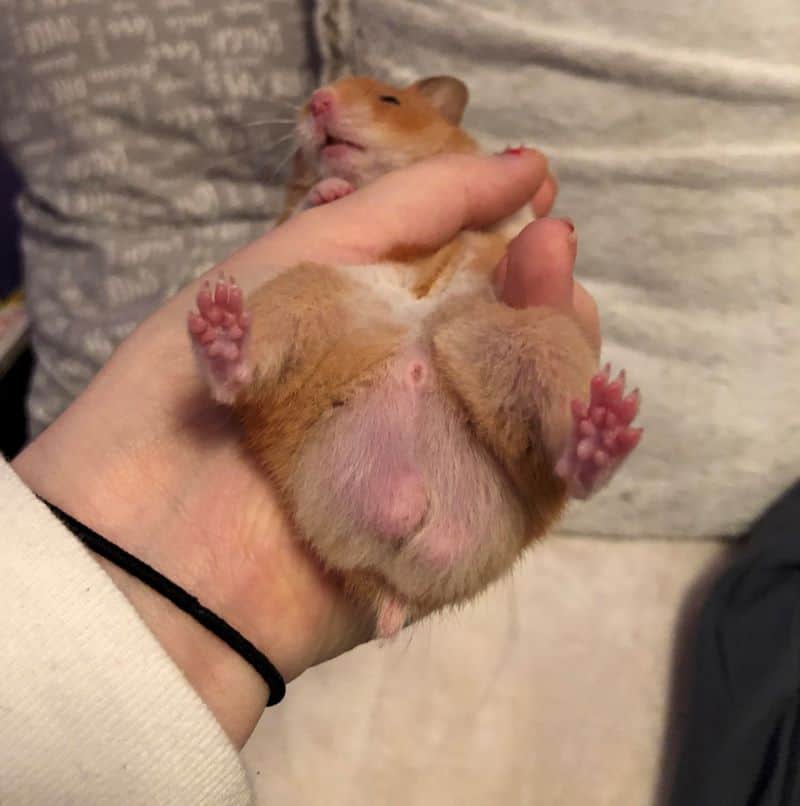This article dives into testicular tumors in hamsters and discusses the origins of the condition. We also reveal a few signs of the fatal cancer and the best treatment options available after an official diagnosis.
If you’ve noticed sizable lumps on your hamster’s balls, please pay attention for the next couple of minutes. Hopefully, we’ll be able to allay your fears if there’s nothing to worry about.
Table of Contents
What Are Testicular Tumors in Hamsters?
Testicular tumors in hamsters occur when males experience excessive cell growths in the balls resulting in lumps. The hardened lumps show signs of swelling due to pressure from the inside, and may not even retract during cold weather like normal.
Hamsters have massive testicles compared to the rest of the body and many first-timers can be amazed at this fact. However, what if you notice lumps on the little guy’s balls during physical examinations? Could that be a sign of a tumor and if yes, is it benign or malignant?
Discovering testicular lumps often sends hamster parents into panic mode. But not all excess growths are tumors and sometimes, it is nothing more than a bit of nuisance for the little guy with no serious health implications.
Signs of Testicular Tumors in Hamsters
If you suspect that your hamster may be saddled with testicular tumors, the safest bet is to consult a vet for diagnosis. However, the following signs in male hamsters are common clues associated with the condition.
Swollen and Lumpy Testicles

The most obvious sign of testicular tumors in hamsters is swollen and lumpy balls. Male hamsters have enormous testicles that set them apart from other rodents. However, the appearance of lumps can make them even bigger overnight.
Lumps typically start small but may grow larger over time. Sometimes, the lumps can even double the original size of the testicles making it apparent with a quick glance. Lumps may be benign or malignant but you can only be sure after contacting a vet for proper analysis and diagnosis.
The presence of lumps typically make the little guy’s testicles firmer than normal and the difference should be clear by just touching them. In some cases, one testicle can appear significantly larger than the other.
If you’ve built a good rapport with your hamster, picking him up and examining the balls for signs of lumps or tumors should not be a problem. However, make sure he’s awake first to prevent the risk of accidental bites.
Discolored Testicles
A hamster’s massive testicles appear typically reddish in color. Apart from the apparent growth in size, the testicles often get discolored when a tumor starts growing inside. It is not uncommon for the affected testicle to look darkish while the healthy one stays normal.
Even with small lumps, the testicular discoloration should set alarm bells ringing for the arrangement of a quick checkup at your local veterinary clinic.
Hates Being Picked Up
If a male hamster that has always loved physical contact suddenly shows resistance, that could be a sign of testicular cancer. While a general examination of the body may be necessary, you should probably start by examining his balls.
Debilitating pain in the balls is a common symptom among hamsters suffering from testicular tumors. Picking them up can make the situation worse as physical contact usually escalates the pain. The result is an extremely playful hamster that suddenly prefers being left alone in the cage.
Loss of Appetite
Hamsters eat throughout the night when they’re usually awake and physically active. They may sometimes wake up from daytime naps to enjoy some chow before resuming sleep when hungry. However, the discomfort from illnesses such as testicular cancer can affect their appetites significantly.
If your foodie hamster refuses to eat or drink like usual, it is time to conduct a proper physical examination even before a trip to the vet. Who knows? You may end up discovering large cell growths in the testicles.
Declined Physical Activity

If you have any experience raising hamsters, you’re aware of their need for constant physical activity, especially from the hours of dusk to dawn. Running around in their cages, moving through tunnels and hideouts, and running on exercise wheels are a few of their favorite activities.
Hamsters suffering from testicular cancer may become lazy overnight and engage in significantly less exercises. In some instances, they can even stop moving and stay in one place throughout their waking hours.
Conduct a full physical examination of a male hamster’s testicles for signs of abnormalities once you notice declined physical activity. It could be due to the growth of cancerous cells in the balls.
Abnormal Walking
Changes in the hamster’s way of walking can be an obvious sign that all is not well downstairs. The pain from the testicular tumor coupled with inflammation of the already massive balls may affect the little guy’s way of walking.
It is not unusual for male hamsters to lift their butt a little during movements as the enlarged testicles act as a barrier.
Stopped Self-Grooming
Self-grooming is a constant activity in hamsters but they might let themselves go when suffering from illness. Grooming enables them to clean their furs and clip toenails in order to enjoy good health and vitality.
Hamsters battling testicular cancers often neglect to groom as the discomfort from the illness can leave them with little energy.
Treatment for Testicular Tumors in Hamsters
Once your hamster is diagnosed with testicular cancer, it is time to look for treatment. Unfortunately, there are only 2 viable options for curing testicular tumors. There’s a third option discussed below but your hammy’s chances of survival may not be too great.
1. Feed Dandelions to Affected Hamsters

Dandelions are healthy green leafy vegetables recommended for hamsters battling testicular cancer. It provides powerful vitamins such as A and C which invigorate the pet rodent’s immune system to repel diseases.
Dandelions can be a critical herb for hamsters because it contains natural diuretic properties that ensure that the tumors do not suffer fluid buildup. Pus accumulation around the affected balls may worsen the swelling and exacerbate the affected hamster’s discomfort.
2. Castration or Testicular Surgery
Testicular surgery is the most effective method for treating tumors in male hamsters’ balls. Also known as castration, it involves the removal of one or more testicles so the little guy can enjoy a happy and productive life.
The surgery is typically conducted by an exotics vet in a clinic with local anesthesia. The time frame is often less than an hour and the hamster may be kept overnight for further observations. Surgery can prevent cancer from spreading to other vital organs resulting in death.
3. Chemotherapy
Chemotherapy is another option for treating testicular tumors in hamsters. It often involves targeting the affected balls with radiation therapy to kill the cancerous cells.
Unfortunately, chemotherapy can take a heavy toll on hamsters and most of them may not even survive. But, it is worth discussing with your vet to know your options.
Are Tumors Common in Hamsters?
Tumors are nothing new in the bodies of hamsters, guinea pigs, and gerbils. The excess cell growths may be classified as benign or malignant after tests. Malignant tumors are cancerous cells that may spread to other organs in the body.
Tumors are common in areas such as the adrenal glands, lymphatic system, stomach, and testicles. Regular physical examinations at home can reveal the presence of lumps in the affected areas for follow-up examinations by a vet.
Can Hamsters Survive Testicular Tumors?
Hamsters may survive testicular tumors if detected and treated early. Surgical removal of the cancerous cells before they advance to other organs typically leads to full recovery.
It is not uncommon for hamsters to live for more than a year after receiving early treatment for tumors in different areas.
What to Do With a Hamster That Has a Tumor
Surgical removal is always the first option for hamsters diagnosed with tumors. However, if surgery is not viable because of financial constraints or the cancer has already spread to vital organs, euthanasia may be considered.
Hamsters can be safely put down at home or taken to vets for quick and painless euthanasia. It is up to you to make the right choice taking into account how much pain the little guy may be suffering day in and day out.
Conclusion: Testicular Tumors in Hamsters
Testicular tumors in male hamsters are characterized by lumps in the balls usually discovered during routine physical examinations. While they naturally have gigantic balls relative to the rest of their bodies, the presence of tumors can make them even larger.
Testicular tumors are often treated by surgical removal of the affected testicles. The surgery may last less than an hour and your sick buddy should recover fully within a week or so. As long as you provide the right post-surgery care, your hamster will be back on its feet shortly.

